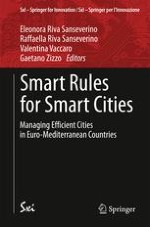This book explores the new rules and codes that are required in order to foster the implementation of smart city technologies with a view to meeting the environmental and energy challenges posed by dynamic contemporary cities with increasing populations. In particular, it proposes a methodological approach suitable for use when devising a smart urban/building code for local administrations, taking into account the current European regulatory framework (directives and technical norms) and evaluating the economic feasibility of the suggested measures. A case study is made of a large Mediterranean city in Italy that can be regarded as a paradigm of urban evolution, where a traditional individualism poses a cultural obstacle to the emerging need to share resources. Further features include a smart cities atlas, explanation of how to create local rules for sustainable building restoration/construction, and guidance on economic evaluation of the impact of building automation and passive measures for energy efficiency. The book, which has a multidisciplinary perspective, will be of value to all who are interested in the transition to smart cities that can meet sustainable development targets.
